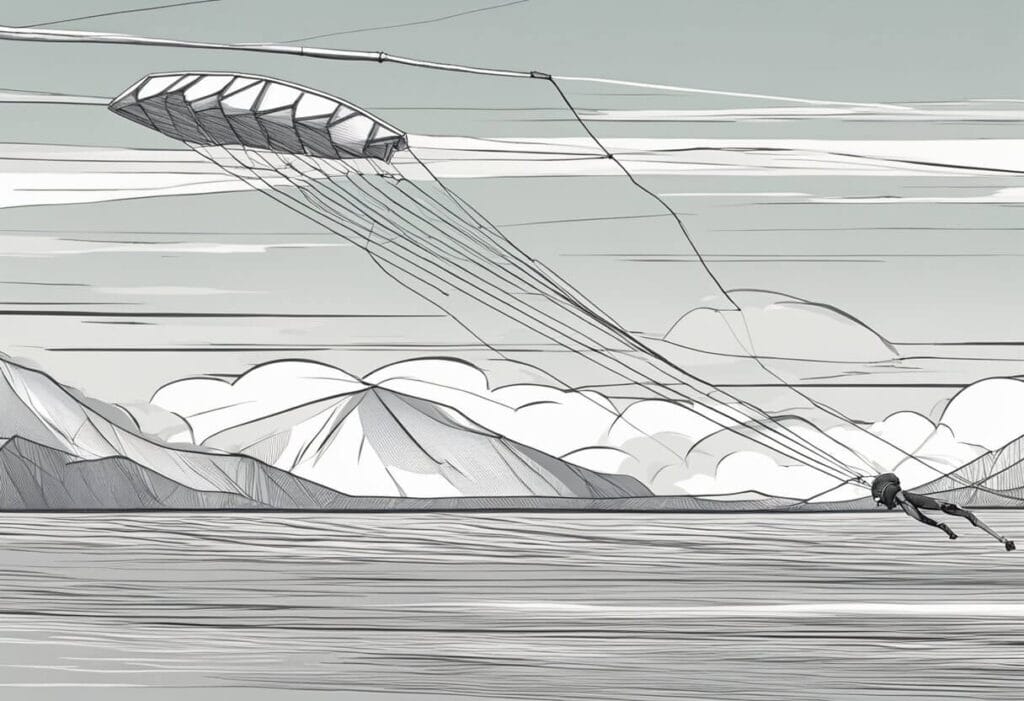String plays a critical role in kite flying as it connects the kite to the ground, allowing you to control its movements. The role of string in kite flying is to ensure the kite will not float away with the wind. The length and strength of the string used in kite flying can significantly impact the kite’s performance. A longer string allows the kite to fly higher and catch stronger winds, while a shorter string provides more control and stability. The strength of the string must also be considered, as a weak string can break under the pressure of strong winds or a heavy kite.
The Basics of Kite Flying
Kite flying is an art and a leisure activity that has been around for centuries. When flying a kite, the string is attached to the kite and held by the person flying the kite. The person can control the kite’s direction and altitude by pulling or releasing the string.
The string is a critical component of kite flying, providing control, stability, and safety. The length of the string also affects the kite’s flight, with longer strings allowing the kite to fly higher and shorter strings keeping the kite closer to the ground.
The string used for kite flying is typically made of a strong, lightweight material, such as nylon or polyester. It is essential to choose a string that can withstand the wind’s force and the kite’s weight without breaking. The string’s thickness also affects the kite’s flight, with thicker strings providing more stability and control.
In addition to controlling the kite’s movement, the string also serves as a safety measure. It helps prevent the kite from flying away and getting lost or causing damage to property or people. When flying a kite, keeping the string taut is crucial, as well as avoiding letting it become tangled or knotted.

Aerodynamics And Forces And The Role Of String In Kite Flying
Kite flying is all about aerodynamics and forces. The four forces that act on a kite are lift, weight, thrust, and drag. Lift is the force that makes the kite fly, which is generated by the motion of air over the kite’s surface. Weight is the force that pulls the kite down towards the ground. Thrust is the force that propels the kite forward, while drag is the force that opposes the kite’s motion.
When a kite is flying, it experiences both aerodynamic and tension forces. The aerodynamic forces are generated by the motion of air over the kite’s surface. The string that connects the kite to the ground generates the tension forces. The tension forces are crucial in keeping the kite stable and preventing it from crashing.
Kite flying heavily relies on the wind as it is the force that produces the aerodynamic forces necessary for the kite to fly. The wind also impacts the tension forces that act on the kite. When there is a strong wind, it can generate more tension in the string, making it harder to control the kite.
The direction of the wind also affects the kite’s flight. If the wind blows directly towards the kite, it can produce more lift, helping it fly higher. If the wind blows across the kite, it can generate more drag, slowing it down.
The Role Of String And Kite Parts
Kite strings, also known as kite lines or cords, connect the kite to the ground or the person flying it. The materials used in kite construction significantly affect the kite’s performance and durability. When selecting materials for kite construction, it is essential to consider factors like strength, durability, and resistance to abrasion and UV rays.
Nylon is the most common material for kite strings because it is strong, durable, and resistant to abrasion and UV rays. Polyester is also popular because it is strong, long-lasting, and resistant to water and UV rays. Although Kevlar is more expensive, it is extremely strong and highly resistant to abrasion and UV rays. Dacron is another material used in kite strings because it is strong, durable, and abrasion-resistant.
Kite Frame and Rods And The Role Of String In Kite Flying
The frame and rod of a kite are the structural components that give it shape and stability. The frame is made up of rods that are connected to form a spine, spreader, and/or spar. The spine is the central rod from the nose to the kite’s tail. The spreader is a horizontal rod that connects the spine to the wings or sails of the kite. The spar is a vertical rod that supports the spreader and gives the kite its shape.
Different methods exist to connect the frame and rods when assembling them. One way is to glue them, which involves applying an adhesive substance to the joints and pressing the pieces together until the glue dries. Another method is to fit them together, which requires precision cutting and shaping the pieces to interlock snugly. Lastly, tying the frame and rods together with string is another option, which involves wrapping string tightly around the joints to hold the pieces in place.
Tying the frame and rods together is often a good option as it allows joint flexibility. To tie them:
- Lay the frame flat and position the rods where they connect.
- Cut pieces of strong kite string or thread in the needed lengths.
- Begin wrapping the string tightly around one joint, crossing it over itself as you go to secure it.
- Tie off the end with a tight knot.
- Wrap and tie each joint securely. The string tension and tightness of the knots will hold the frame and rods together sturdily.
This method allows you to disassemble and store the kite easily for transport. It also lets you adjust the angles of the rods if needed to tune the kite’s flying. With the correct technique, tying the joints can result in a durable, high performing kite frame.
When selecting a string to tie a kite frame, the best choice is typically a strong, thin kite string or thread. Nylon kite string is an excellent option as it is durable yet lightweight. The thin diameter allows for tightly wrapping joints while keeping the knots small. Nylon withstands stretching and abrasion far better than many alternatives like cotton thread or twine. This minimizes the chance of the string loosening over time, which is critical for maintaining a rigid, aerodynamic kite frame.
Waxed kite string can provide even greater friction and grip when tied around joints. The wax coating helps the knots stay tightly bound and reduces string fraying. Waxed string may be slightly thicker than unwaxed varieties but often thin enough for effective tying. Ensure the wax is smooth and does not add too much bulk around knots. For the highest strength, braided or twisted kite string is ideal. The woven structure resists breakage from tension better than single-ply threads. You can confidently fly the kite with quality braided kite string, knowing the sturdy joints will hold against strong winds and strain.
When tying and tuning the kite, always remember to leave some flex in the joints by not over-tightening the string. The frame needs a bit of give to handle pressure. But overall, selecting a thin, durable kite string and tying it tightly around joints creates a reliably rigid frame that can withstand flights repeatedly.

Sail and Tail And The Role Of String In Kite Flying
The sail and tail are two critical kite parts that work together to catch the wind and generate lift. The sail constitutes the central body of the kite, constructed using lightweight and durable materials. On the other hand, the tail is a lengthy and thin strip of material that attaches to the bottom of the kite. The tail’s primary function is stabilizing the kite and preventing it from spinning out of control.
When selecting string for the kite’s sail and tail, the primary considerations are strength and lightness. The string must be strong enough to withstand the tension and forces of high winds to weigh down the kite and impact maneuverability. For the sail, high quality braided kite string is ideal. It has excellent tensile strength while remaining lightweight. Waxed varieties provide extra grip and abrasion resistance where the string attaches to the frame, but lighter cotton or synthetic twine is often used for the tail. Though less robust than specialized kite string, the tail experiences less tension so that cheaper string can suffice. The longer tail helps compensate if the string does stretch or break. Securely tying the string to the kite and tail is critical, and knot choice and technique will impact the connections’ strength and longevity. With appropriately selected string and properly tied knots, the sail and tail will work harmoniously to provide stable, controlled flight.
One of the most reliable knots for kite string is the lark’s head knot, also used in macrame. To tie it, make a loop at the end of the string. Pass the loop through or around the attachment point on the kite, then pass the actual string end through the loop and tighten it down. The loop-on-loop configuration provides tremendous gripping power. The lark’s head knot is quick and easy to tie, even with cold fingers on a blustery day. For extra security, you can tie the knot twice or augment it with an overhand knot tied after the lark’s head. The lark’s head’s combination of binding power, ease of tying, and streamlined profile make it the top choice for keeping kite string attached, allowing you to confidently launch, maneuver, and reel in your kite.
Bridle and Control Lines
The bridle and control lines are the parts of the kite that allow you to control its flight. The bridle is a string set that runs from the kite to the control lines. The bridle holds the kite at an angle to the flying line, which affects the kite’s flying ability. The control lines are the strings that you use to control the kite’s movements. Pulling on one side of the control lines causes the kite to turn in that direction. It is essential to use the correct type of kite line for the size and weight of your kite to ensure safe and successful flying.
String Strength, Weight, Length And Stretch
The strength and weight of the string are critical factors to consider when flying a kite. The string must be strong enough to withstand the tension and pull of the kite without breaking. At the same time, it should be lightweight enough to allow the kite to fly freely in the air. Kite strings are available in different weights, ranging from heavy-duty to lightweight. The weight of the string needed will depend on the size and weight of the kite.
The length and stretch of the string also play a crucial role in kite flying. The length of the kite string will guide how high it can fly, while the stretch will affect the kite’s stability and maneuverability. The longer the string, the higher the kite can fly. However, longer strings are more prone to stretching, affecting the kite’s stability. Therefore, it is essential to choose a string that is long enough to allow the kite to fly high but not so long that it becomes unstable.
Here are some recommendations for the best kite string in terms of strength, weight, length and stretch:
Strength: The string should be strong enough to withstand the force of the wind on the kite without breaking. Look for string made of high quality materials like dacron or kevlar, as these tend to be very strong for their weight. Avoid cheap cotton string as it can break easily.
Weight: A lighter string is better as it allows the kite to move more responsively in the wind. Aim for a string that is thin but still maintains good strength through the use of synthetic fibres. 50-100 lb test lines are a good choice for most single-line kites.
Length: For single-line kites, the string length depends on how high you want to fly, but 200-500 feet is standard. Having extra string allows more versatility. For multi-line sport kites, 30-90 feet is typical. Leave some extra length for connecting the lines to the control bar.
Stretch: Minimal stretch is best, so the kite responds instantly to control inputs. Some stretch helps absorb shocks, but too much makes the kite hard to control precisely. Under 10% stretch when fully loaded is ideal.
In summary, look for a thin, lightweight, synthetic solid line with minimal stretch.
String Handling
String handling is another critical aspect of kite flying. How you handle the string can affect the kite’s flight and stability. When winding the string onto the reel or winder, it is essential to ensure it is wound evenly and tightly. Uneven winding can cause the kite to become unstable and difficult to control. It is also important to keep the string taut while flying the kite. A loose string can cause the kite to lose altitude or become unstable.

Tangling and Breakage
One of the most frustrating challenges in kite flying is string tangling. When the kite string becomes tangled, it can be difficult to untangle and even result in the string breaking. Several factors, including wind gusts, improper storage, and improper handling, can cause tangling and breakage. When damage occurs, repair the kite immediately to prevent further damage.
Keeping the kite string taut is vital to prevent tangling, which can be achieved using a kite reel or winder. Additionally, it is important to store the kite string properly to prevent tangling when not in use. An excellent way to do this is to wrap the string around a kite line winder or a piece of cardboard.
If tangling occurs, address the issue immediately to prevent the string from breaking by carefully untangling the string by hand or using scissors to cut away any knots or tangles.
Final Thoughts
String is crucial in kite flying as it controls altitude, direction, and speed. Without the string, the kite could not fly properly and would lose control in the air. The string’s length, weight, and strength significantly determine the kite’s performance and stability. Choosing the correct type of string based on the kite’s size, weight, and wind conditions is essential to ensure a successful and enjoyable kite flying experience.
Frequently Asked Questions
What materials are necessary for kite flying?
The minimum is a frame, paper and string.
What is the importance of a tail on a kite?
A kite’s tail helps stabilize and prevent it from flipping over or spinning out of control. The tail works by creating drag, which counteracts the lift of the kite and keeps it from becoming unstable. The length and weight of the tail can affect how well it stabilizes the kite, with longer and heavier tails providing more stability.
Are there any alternatives to traditional kite string?
While traditional kite string is typically made of materials like cotton, nylon, or polyester, alternative materials can be used. Some people use fishing line or even dental floss to fly their kites.
What is the history behind kite flying and its materials?
Kite flying has been around for thousands of years in many cultures worldwide. The materials used to make kites have evolved, with early kites made of bamboo, silk, paper, and fabric. Today, kites are made of various materials, including lightweight plastics and synthetic fabrics.









